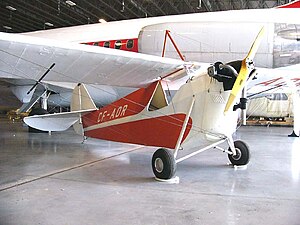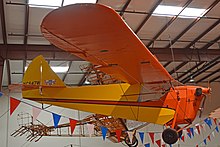| Aeronca C-2 | |
|---|---|

| |
| Aeronca C-2 in the Canada Aviation and Space Museum | |
| Role | Monoplane |
| National origin | United States |
| Manufacturer | Aeronca Aircraft |
| Designer | Jean A. Roche |
| First flight | 1929 |
| Number built | 164 |
| Developed from | 1925 Roche Monoplane |
| Variants | C-1 Cadet, Aeronca C-3 Master |
The Aeronca C-2 is an American light monoplane designed by Jean A. Roche and built by Aeronca Aircraft.
Development
Roche Monoplane
Jean A. Roche was a U.S. Army engineer at McCook Field airfield in Dayton, Ohio. Roche developed an aircraft with automatic stability and was granted U. S. Patent No. 1,085,461. Roche published his engineering ideas for the aircraft in Aerial Age Weekly and Slipstream Monthly magazines. The prototype was started in Ohio in 1923 with the assistance of fellow engineer Quinten Dohse. The aircraft used a triangular cross-section welded steel tube fuselage, with wood wings, was fabric-covered, and used wire bracing throughout. A Henderson engine was installed, but did not perform well. Next a custom 29 hp two-cylinder Morehouse engine was developed for the aircraft. On September 1, 1925, the aircraft was successfully test flown. Many pilots including Jimmy Doolittle tried out the aircraft. Wright Aeronautical hired Morehouse and rights to his Wright-Morehouse WM-80 engine. Left without an engine, They turned to Robert E. Galloway of the Aeronautical Corporation of America to use the Aeronca E-107 engine. The rights to the aircraft were sold to Aeronca in 1928 as the basis for the C-2 Design. [1]
Aeronca C-2
The Aeronca C-2, powered by a tiny two-cylinder engine, made its first flight in October [2] 1929, with its public debut in St. Louis in February 1930. [2] It was flying at its most basic—the pilot sat on a bare plywood board. The C-2 featured an unusual, almost frivolous design with an open-pod fuselage that inspired its nickname, The Flying Bathtub. (It was also nicknamed "Airknocker" and "Razorback". [2]) The general design of the C-2 could have been inspired by Jean Roche's initial flight experiences with an American-built copy of the Santos-Dumont Demoiselle, which had a similar triangular "basic" fuselage cross-section, and wire-spoked main landing gear wheels against the fuselage sides.[ citation needed] The C designation derived from the fact that Aeronca had earlier been formed as the Cincinnati Aeronautical Corporation, [3]
Equipped with only four instruments (altimeter, oil temperature, oil pressure, and tachometer), [2] a stick, and rudder pedals (brakes and a heater at extra cost), the C-2 was priced at a low $1,555 (later US$1,245), [2] bringing the cost of flying down to a level that a private citizen could perhaps reach. [4] Aeronca sold 164 of the economical C-2s at the height of the Great Depression in 1930-1931, helping to spark the growth of private aviation in the United States. [5]
The Aeronca C-2 also holds the distinction of being the first aircraft to be refueled from a moving automobile. A can of gasoline was handed up from a speeding Austin automobile to a C-2 pilot, (who hooked it with a wooden cane) during a 1930 air show in California.[ citation needed]
A single Aeronca C-2, G-ABHE, was converted to a glider by H.J. Parham in England after an in-flight engine failure and forced landing. The nose was faired in after the removal of the engine. It first flew as a glider 15 May 1937 and went to the Dorset Glider Club but was destroyed in the club hangar during a storm in November 1938. [6]
Variants
- Aeronca C-2
- Single-seat light sporting aircraft, powered by a 26 horsepower (19 kW) Aeronca E-113 piston engine. [3]
- Aeronca C-2 Collegian
- Improved two-seat version, with a wider fuselage, a 40 horsepower (30 kW) E-113A engine, and a number of design improvements but retaining the open cockpit and strut-braced undercarriage. Confusingly, Aeronca renamed this version the C-3 Collegian. [3]

- Aeronca C-2N Scout
- Deluxe sporting aircraft, powered by a 36-hp (27-kW) Aeronca E-112 or E-133A piston engine. Four built. [7]
Note that a P prefix, as in PC-2N, would indicate that the aircraft was fitted with floats, P standing for Pontoon. [8]
Surviving aircraft


- Canada
- A-9 – C-2 CF-AOR on static display at the Canada Aviation and Space Museum in Ottawa, Ontario. [9]
- United Kingdom
- A-100 – C-2 (modified) G-ABHE under long-term restoration in Cornwall, England as a composite, modified to comply with microlight aircraft rules. [10]
- United States
- 2 – C-2 NX626N on static display at the Udvar-Hazy Center of the National Air and Space Museum in Chantilly, Virginia. It is the first production prototype of the Aeronca C-2. It was donated to the museum in 1948 by Aeronca and was restored in 1976. [11] [12]
- 27 – C-2 Sport NC647W airworthy at the Yanks Air Museum in Chino, California. [13] [14]
- 66 – C-2 NC10304 on static display at the Ohio History Center in Columbus, Ohio. [15] [16]
- A-106 – C-2N NC11276 airworthy, owned by Craig MacVeigh [17] of New Carlisle, Ohio. [18]
- A-151 – C-2N Scout N11417 was built as an Aeronca C-1 Cadet but was soon converted to a C-2N. It is on display at the Shannon Air Museum in Fredericksburg, Virginia. [19] [20]
- A-253 – C-2N Scout N13089 on static display at the EAA AirVenture Museum in Oshkosh, Wisconsin. This aircraft set seven records, five of which were for seaplanes. [7] [8]
- 301-23 – C-2 N30RC on static display at the Museum of Flight in Seattle, Washington. [21] [22]
Specifications (C-2)
Data from Aeronca C-2: The Story of the Flying Bathtub [23]
General characteristics
- Crew: one
- Length: 20 ft 0 in (6.10 m)
- Wingspan: 36 ft 0 in (10.98 m)
- Height: 7 ft 6 in (2.28 m)
- Wing area: 142.2 sq ft (13.2 m2)
- Empty weight: 406 lb (184 kg)
- Powerplant: 1 × Aeronca E-107 1.75L flathead piston engine, 26–30 hp (19–22 kW)
Performance
- Maximum speed: 80 mph (128 km/h, 70 kn)
- Cruise speed: 65 mph (104 km/h, 56 kn)
- Stall speed: 31 mph (50 km/h, 27 kn)
- Range: 240 mi (384 km, 210 nmi)
- Service ceiling: 16,500 ft (5,032 m)
- Wing loading: 4.92 lb/sq ft (24 kg/m2)
See also
Related development
Aircraft of comparable role, configuration, and era
References
- ^ McRae, Jack (June 1958). "This Month's Old Timer: The Roche' Monoplane". Sport Aviation. EAA: 14–15.
- ^ a b c d e Payne, Stephen, ed. Canadian Wings (Douglas & McIntyre, Ltd., 2006), p.163.
- ^ a b c Ord-Hume, Arthur W. J. G. (January 1998). "The Aeronca Experience". Aeroplane Monthly. 26 (297): 56–61.
- ^ Donald M. Pattillo. A History in the Making: 80 Turbulent Years in the American General Aviation Industry. p. 18.
- ^ Parks, Dennis (10 December 2015). "Aeronca C-2: Small plane, big records". General Aviation News. Flyer Media Inc. Retrieved 5 December 2023.
- ^ Ellison, Norman (1971). British Gliders and Sailplanes. London: A & C Black Ltd. p. 80. ISBN 0-7136-1189-8.
- ^ a b "1933 Aeronca C-2-N Deluxe Scout - NC13089". EAA Museum. EAA. Retrieved 4 December 2023.
- ^ a b "Aeronca Aircraft On Display EAA Museum, Oshkosh, Wisconsin (Part 1)" (PDF). National Aeronca Association Magazine. 13 (4): 10. 2014. Archived from the original (PDF) on 14 March 2016. Retrieved 4 December 2023.
- ^ "Aeronca C-2". Canada Aviation and Space Museum. Ingenium. Retrieved 4 December 2023.
- ^ "Aircraft". Flying For Fun - Trecanair. Retrieved 4 December 2023.
- ^ "Aeronca C-2". National Air and Space Museum. Smithsonian. Retrieved 4 December 2023.
- ^ "FAA Registry [N626N]". Federal Aviation Administration. U.S. Department of Transportation. Retrieved 4 December 2023.
- ^ "Aeronca C-2 Sport". Yanks Air Museum. Retrieved 4 December 2023.
- ^ "FAA Registry [N647W]". Federal Aviation Administration. U.S. Department of Transportation. Retrieved 4 December 2023.
- ^ "Aeronca C-2 - Untitled". Airliners.net. Retrieved 4 December 2023.
- ^ "FAA Registry [N10304]". Federal Aviation Administration. U.S. Department of Transportation. Retrieved 4 December 2023.
- ^ "Craig MacVeigh's Aeronca C-2 Project". Antique Airfield. Antique Aircraft Association and Airpower Museum. 24 January 2009. Archived from the original on 16 December 2021. Retrieved 4 December 2023.
- ^ "FAA Registry [N11276]". Federal Aviation Administration. U.S. Department of Transportation. Retrieved 4 December 2023.
- ^ "CIVILIAN AIRCRAFT". Virginia Aviation Museum. Archived from the original on 17 April 2016. Retrieved 17 November 2016.
- ^ "FAA Registry [N11417]". Federal Aviation Administration. U.S. Department of Transportation. Retrieved 4 December 2023.
- ^ "Aeronca C-2". The Museum Of Flight. Retrieved 4 December 2023.
- ^ "FAA Registry [N30RC]". Federal Aviation Administration. U.S. Department of Transportation. Retrieved 4 December 2023.
- ^ Spenser, Jay P. (1978). Aeronca C-2: The Story of the Flying Bathtub. Washington, D.C.: Smithsonian Institution Press. p. 71. ISBN 0-87474-879-8.